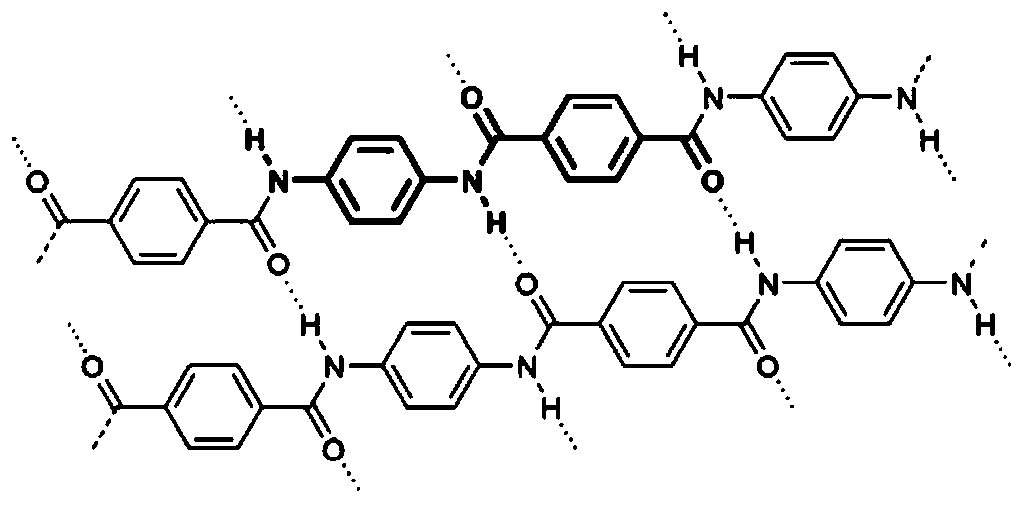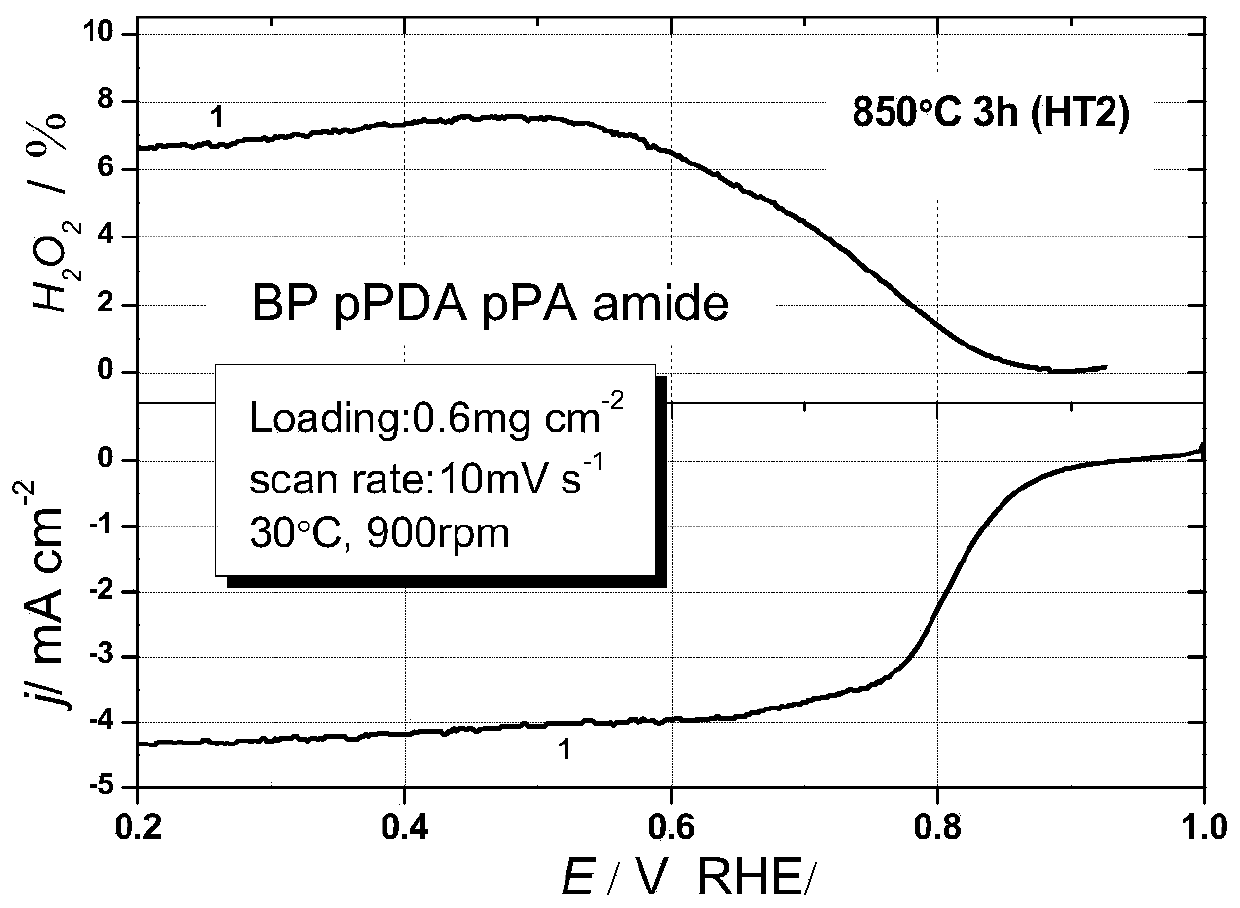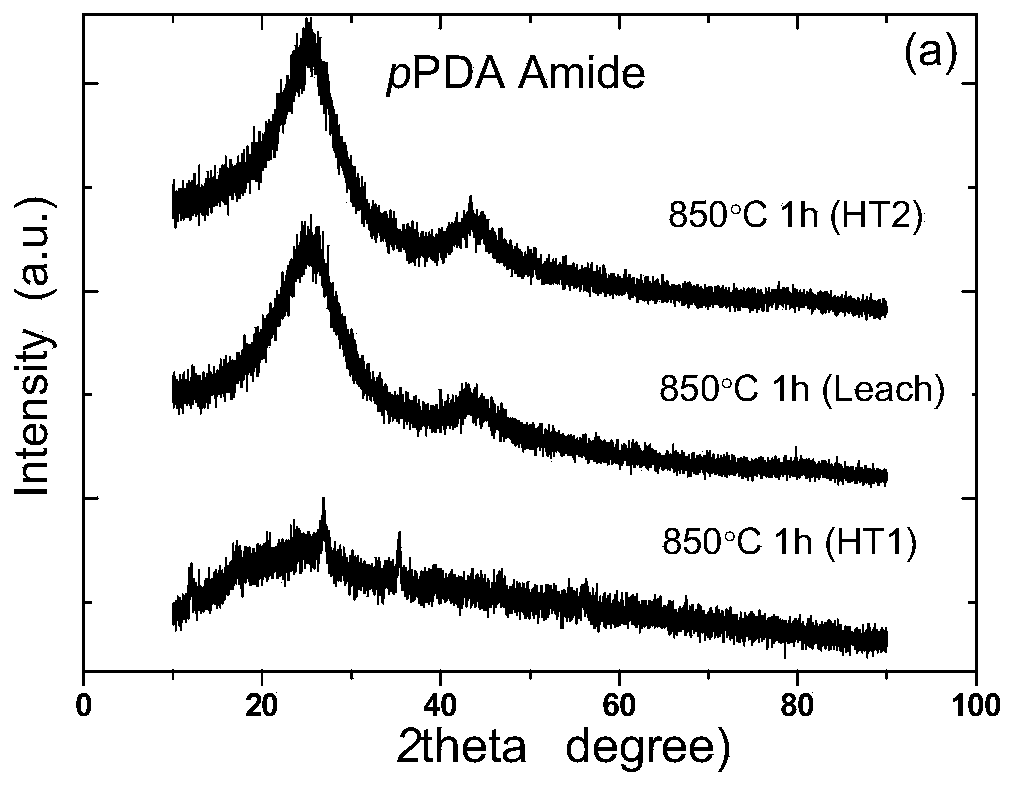Preparation method for oxygen-reduction electrocatalyst taking aramid amide as main precursor
A technology of aramid and electrocatalyst, which is applied in circuits, electrical components, battery electrodes, etc., can solve the problems of high cost and high price of fuel cells, and achieve the effects of easy mass production, low cost, and guaranteed stability
- Summary
- Abstract
- Description
- Claims
- Application Information
AI Technical Summary
Problems solved by technology
Method used
Image
Examples
preparation example Construction
[0038] The preparation method of the oxygen reduction electrocatalyst comprises the following steps:
[0039] (1) Dissolution: Dissolve carbon black in deionized water by wet sieving (that is, grinding through a 100-mesh sieve after adding water), ultrasonication for a long time, stirring and dispersing evenly, and then storing at low temperature.
[0040] The proportioning of described carbon black and deionized water can be 2g:420mL, and wherein carbon black is calculated by mass, and deionized water is calculated by volume; The time of described ultrasonic can be 1~20h; The temperature of described preservation can be 0 ~10°C.
[0041] (2) Coating polymer: add hydrochloric acid to the carbon black solution stored at 0-10°C, and 5-50 mL of 36% concentrated hydrochloric acid may be added. The amount of m-phenylenediamine added can be 1-50 g; the temperature under the low temperature condition can be 0-10° C.; the phthalic acid is a phthalic acid solution cooled with ice wate...
Embodiment 1
[0054] (1) Carbon black sieving: First, 2 g of Ketjenblack EC600JD carbon black (KJ600 for short) was sieved, dissolved in 400 mL of deionized water, and ultrasonicated for 8 hours, so that the carbon black was evenly dispersed in the water. Store at a low temperature of 0-10°C for later use.
[0055] (2) Coating polymer: add 100mL of concentrated hydrochloric acid with a concentration of 36% by mass to the carbon black solution, then add 10g of p-phenylenediamine (i.e. nitrogen source), and mechanically stir for 3 hours at a low temperature of 0-10°C to disperse the sample uniform. The terephthalic acid solution (10 g of terephthalic acid content) was previously cooled with ice water, and slowly added dropwise. The carbon black solution (KJ600-(PmPDA+pPA)) wrapped with the polymer was obtained by in-situ polymerization under low temperature condition of 0-10°C for 12 hours.
[0056] (3) Water washing: directly filter the carbon black solution wrapped in the polymer in situ,...
Embodiment 2
[0063] (1) Carbon black sieving: first sieve 2g of Ketjenblack EC300J carbon black, dissolve it in 400mL of deionized water, ultrasonicate for 8 hours, and then mechanically stir for 1 hour to further disperse the carbon black in the water evenly. Store at a low temperature of 0-10°C for later use.
[0064] (2) Encapsulating the polymer: Add 70 mL of 36% concentrated hydrochloric acid to the carbon black solution, then add 20 g of p-phenylenediamine (ie nitrogen source), and mechanically stir for 3 hours at a low temperature of 0-10°C to disperse the sample evenly. The terephthalic acid solution (20 g of terephthalic acid content) was pre-cooled with ice water and slowly added dropwise. Stirring at a low temperature of 0-10°C for 12 hours, in-situ polymerization to obtain a conductive carbon black solution coated with aramid polymer in-situ.
[0065] (3) Water washing: directly filter the conductive carbon black solution coated with the polymer in situ, wash it several times ...
PUM
| Property | Measurement | Unit |
|---|---|---|
| electrical resistivity | aaaaa | aaaaa |
Abstract
Description
Claims
Application Information
 Login to View More
Login to View More - R&D
- Intellectual Property
- Life Sciences
- Materials
- Tech Scout
- Unparalleled Data Quality
- Higher Quality Content
- 60% Fewer Hallucinations
Browse by: Latest US Patents, China's latest patents, Technical Efficacy Thesaurus, Application Domain, Technology Topic, Popular Technical Reports.
© 2025 PatSnap. All rights reserved.Legal|Privacy policy|Modern Slavery Act Transparency Statement|Sitemap|About US| Contact US: help@patsnap.com



